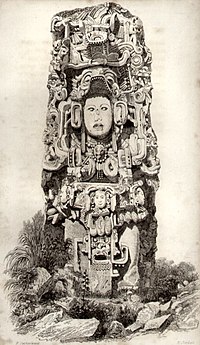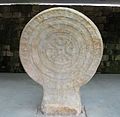Stele

A stele (from Greek: στήλη, stēlē, /ˈstiːli/; plural: stelae, στῆλαι, stēlai, /ˈstiːlaɪ/; also found: Latinised singular stela and Anglicised plural steles) is a stone or wooden slab, generally taller than it is wide, erected for funerary or commemorative purposes, most usually decorated with the names and titles of the deceased or living — inscribed, carved in relief (bas-relief, sunken-relief, high-relief, etc), or painted onto the slab.
History and function
Stelae were also used as territorial markers, as the boundary stelae of Akhenaton at Amarna,[1] or to commemorate military victories.[2] They were widely used in the Ancient Near East, Greece, Egypt, Ethiopia, and, quite independently, in China and some Buddhist cultures (see the Nestorian Stele), and, more surely independently, by Mesoamerican civilisations, notably the Olmec[3] and Maya.[4] The huge number of stelae surviving from ancient Egypt and in Central America constitute one of the largest and most significant sources of information on those civilisations. An informative stele of Tiglath-Pileser III is preserved in the British Museum. Two stelae built into the walls of a church are major documents relating to the Etruscan language.
Unfinished standing stones, set up without inscriptions from Libya in North Africa to Scotland were monuments of pre-literate Megalithic cultures in the Late Stone Age.
In 1489, 1512, and 1663 CE, the Kaifeng Jews of China left these stone monuments to preserve their origin and history. Despite repeated flooding of the Yellow River, destroying their synagogue time and time again, these stelae survived to tell their tale.
An obelisk is a specialized kind of stele. The Celtic high crosses of Ireland, Scotland, and Wales are specialized stelae. Likewise, the Totem pole of North and South America is a type of stelae. Gravestones with inscribed epitaph are also kinds of stelae.
Most recently, in the Memorial to the Murdered Jews of Europe in Berlin, the architect Peter Eisenman created a field of some 2,700 blank stelae.[5] The memorial is meant to be read not only as the field, but also as an erasure of data that refer to memory of the Holocaust.
Notable individual stelae
- Axumite Stele
- Code of Hammurabi
- Gwanggaeto Stele
- Nestorian Stele
- Ukrainian stone stela
- Lemnos stela
- Lapis Niger
- For Israel/Egypt:
- For Egypt:
- In the Western Hemisphere:
- Peru: Raimondi Stela
- Mexico: Stela C at Tres Zapotes
- Mexico: Izapa Stela 5
- Mexico: La Mojarra Stela 1
Gallery
-
Ancient Egyptian funerary stele
-
The Rosetta Stone in the British Museum
-
3-D view of Rosetta Stone-Left side
-
Scythian 5th–4th c.BC. Salbyk kurgan surrounded by balbals with kurgan obelisk on the top. Upper Enisey-Irtysh interfluvial
See also
- Inscription
- Stele Forest, in Xi'an, China
- Rune stone
- Monumental inscription
- Hilarri or Basque steles
Bibliography
- John Boardman ed., The Cambridge Ancient History, Part 1, 2nd Edition, (ISBN-13: 9780521224963 | ISBN-10: 0521224969)
- Christopher A. Pool, Olmec Archaeology and Early Mesoamerica, Cambridge University Press 2007 (ISBN-13: 9780521783125)
- Karen E. Till, The New Berlin: Memory, Politics, Place, University of Minnesota Press 2005
Footnotes and references
- ^ Memoirs By Egypt Exploration Society Archaeological Survey of Egypt 1908, p. 19
- ^ e.g. Piye's victory stela (M. Lichtheim, Ancient Egyptian Literature Vol 3, The University of California Press 1980, , pp.66ff) or Shalmaneser's stela at Saluria (Boardman, op.cit, p.335)
- ^ Pool, op.cit., p.265
- ^ Pool, op.cit., p.277
- ^ Till, op.cit., p.168








